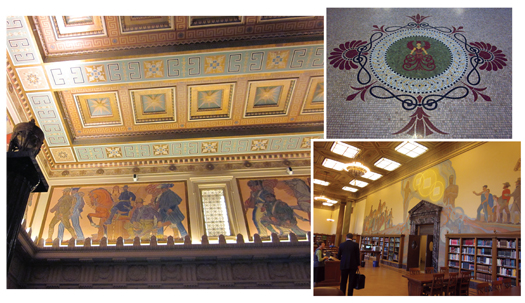UpClose: History, Updated | Library by Design, Spring 2014
After completing a complicated four-plus-year construction project, the Golden State is seeking silver this time—a Leadership in Energy & Environmental Design (LEED) Silver certification for its newly renovated Stanley Mosk Library and Courts Building, to be precise. The reopening celebration for the California State Library (CSL) was held in February and capped a remarkable collaborative effort led by California’s Department of General Services (DGS), landlords of the property.

PERIOD DETAILS (Clockwise, from top l.): Updates like smoke detectors, fire-suppression heads, and security cameras are unobtrusive against the Frank Van Sloan mural in the memorial vestibule; newly uncovered floor tile in the circulation room; reference librarian Suzanne Grimshaw helps a customer in
the Gillis Reading Room
Undoing unimprovements
Rude surprises awaited the contractors behind every wall. The walls themselves—where one might have hoped to thread cabling and pipe—were solid. Therefore, most of the rework occurred in the ceiling crawl spaces. The plumbing system had dead ends and defied logic, becoming a total redo. Hi-Fog, a relatively new form of fire suppression designed to use 80 percent less water than a typical water-based system, was installed throughout—with superb camouflaging. Only careful examination can discover the disguised sprinkler heads in the gorgeous painted ceilings. The core of the five-story edifice houses two light wells and a stack tower, and this area had suffered over the years. HVAC ducting, installed in the 1970s, had closed off the light wells. These wells are now uncovered, bringing in natural light. Where artificial light is necessary, dropped ceilings and fluorescent panels have been replaced with the original chandeliers. Sent out to specialists for restorative work, they now host compact fluorescent and LED bulbs. Numerous windows, suffering from dry rot, were repaired and now sport low-e (low-emissivity) coating. Motorized window shades throughout the building replaced mangled venetian blinds and sun-worn draperies. Emergency exit routes used to be a bit dicey. Now two emergency stairwells are easily accessible and each floor includes an ADA area of refuge. Improvements throughout make it possible for the wheelchair-bound to get into the building and navigate all floors with ease. For the library visitor, the most striking two rooms are on the third floor. The Circulation Room, with its two bronze statues, leaded windows, and marble tile floor, retains a wall of card catalogs (a nostalgic touch that’s popular with the public). A circulation desk and black linoleum had covered the tile floor detailing since 1954. Across the hall, two massive leather-covered doors (new cowhides were required!) open to reveal the breathtaking Gillis Reading Room, bathed in natural light and dominated by a stunning Maynard Dixon mural. Dixon, one of the West’s most prominent artists, painted the mural in 1928. The room’s floors are new cork, designed to mimic the original. Amid the period details, modern scanners and printers are available, and the Wi-Fi is robust.Working around the work
All occupants needed to relocate during the renovation. CSL has a second facility (the Annex) across the street, so some materials and staff could go there. A warehouse seven miles away in West Sacramento became home to the Mosk Building’s approximately 35 miles of compact shelving and 15 of its library staffers. David Cismowski, chief, State Library Services Bureau, noted that although budget limitations required that existing compact shelving be reinstalled in the Mosk Building, new shelving has been purchased for the nearby Annex. Staff and materials have been moving back since mid-2013. In a recent phone conversation, former state librarian Susan Hildreth (now director, U.S. Institute of Museum and Library Services) commented that a massive undertaking such as this gives impetus to “rethinking the service strategy.” Early on in the process, she was able to broker a deal with the courts whereby the Annex now totally belongs to the library, while the courts acquired space in the Mosk Building. This agreement helped streamline a previously awkward workflow.A success—affordably
Pella McCormick, project director, is frequently credited with the success of the project. Shelley Whitaker took over from McCormick in late 2012 and closed the work. “The advertisement for services thoughtfully addressed the scope of the project, not the least of which was the preservation of the extensive historic elements of the building,” she wrote in an email. “Along with the skilled team that Carey and Company [architects] brought to the project, Pella created a broad outreach with the client end users that kept them not only part of the design and decision-making process but kept them involved and informed along the way.” The project came in under budget, costing roughly $49 million. For Gary Kurutz, curator emeritus of special collections and the executive director of the CSL Foundation, the final results are dramatic. He told Library by Design that the contractors did a “remarkable job of respecting historicity” and that he “could not have been more pleased.” The California Preservation Foundation recognized the renovation as one of 20 “outstanding” projects for 2013. Those too far away to visit in person can take a virtual tour, courtesy of the California State Library’s website (library.ca.gov).RELATED
RECOMMENDED
TECHNOLOGY
ALREADY A SUBSCRIBER? LOG IN
We are currently offering this content for free. Sign up now to activate your personal profile, where you can save articles for future viewing









Add Comment :-
Comment Policy:
Comment should not be empty !!!